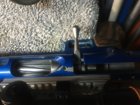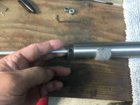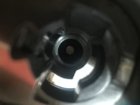I like measuring off the bullet tip, no case needed. All you need is a properly sized aluminum rod, 2 shaft collars and a bullet from your lot that is of the mean avg. length from base to tip. Close the bolt, run the alum. rod to the bolt face, attach first shaft collar at the muzzle crown and remove the rod. Remove bolt, drop your mean average bullet down to the lands (I delicately run a wooden dowel up behind the bullet), run the alum. rod down the bore with the 2nd 'loose' shaft collar until the rod just touches the bullet tip, tighten 2nd collar at the muzzle face. Remove alum. rod with both collars secured and measure between the 2 collar faces that touched the muzzle crown. I take a few measurements around the collars which may only be a few .001" different. This seems more accurate to me than trying to divine where the lands are imprinting on the bullet or whether it has pushed the bullet into the case. I've tried the Wheeler method and have more confidence in the bullet tip method. You can actually feel where the bullet is. "Gird your loins, men...we've got incoming!"
You are using an out of date browser. It may not display this or other websites correctly.
You should upgrade or use an alternative browser.
You should upgrade or use an alternative browser.
finding lands?
- Thread starter TrxR
- Start date
Thanks. Any pictures or videos of this?I like measuring off the bullet tip, no case needed. All you need is a properly sized aluminum rod, 2 shaft collars and a bullet from your lot that is of the mean avg. length from base to tip. Close the bolt, run the alum. rod to the bolt face, attach first shaft collar at the muzzle crown and remove the rod. Remove bolt, drop your mean average bullet down to the lands (I delicately run a wooden dowel up behind the bullet), run the alum. rod down the bore with the 2nd 'loose' shaft collar until the rod just touches the bullet tip, tighten 2nd collar at the muzzle face. Remove alum. rod with both collars secured and measure between the 2 collar faces that touched the muzzle crown. I take a few measurements around the collars which may only be a few .001" different. This seems more accurate to me than trying to divine where the lands are imprinting on the bullet or whether it has pushed the bullet into the case. I've tried the Wheeler method and have more confidence in the bullet tip method. You can actually feel where the bullet is. "Gird your loins, men...we've got incoming!"
This tool will get you very close. Use as directed.
https://www.sinclairintl.com/reload...lair-bullet-seating-depth-tool-prod35491.aspx
https://www.sinclairintl.com/reload...lair-bullet-seating-depth-tool-prod35491.aspx
1)All you need is a properly sized aluminum rod, 2 shaft collars and a bullet from your lot that is of the mean avg. length from base to tip and calipers.Thanks. Any pictures or videos of this?
2)Close the bolt.
3)Run the alum. rod from the muzzle to the bolt face, attach first shaft collar at the muzzle crown.
4)Remove the rod, remove bolt, drop your mean average bullet down to the lands.
5)Delicately run a wooden dowel up behind the bullet
6)Run the alum. rod down the bore with the 2nd 'loose' shaft collar until the rod just touches the bullet tip and tighten 2nd collar at the muzzle face.
7)Remove alum. rod with both collars secured and measure between the 2 collar faces that touched the muzzle crown. Use the bottom of the caliper body and the tip of the depth blade. I take a few measurements around the collars which may only be a few .001" different.
Attachments
bozo699
Gold $$ Contributor
Steelholder,
I’ve shot at Deepcreek with Tom and Alex there both winners!.... let me tell you something I know to be true!.... you use the info however you wish. No one is shooting a 3006 in 1000 yard br, you know why?..... there not what’s winning!.... it’s okay to be different and have something different when your building a street rod but if you want to win at lrbr do what the consistent winners are doing,.... there not shooting grandpas 06 and 4831 for a reason!.... it’s okay to experiment and broaden your knowledge. I would go into a match using loading and shooting techniques that Tom Mousel or Alex Wheeler gave me with confidence, there both winners!
Wayne
I’ve shot at Deepcreek with Tom and Alex there both winners!.... let me tell you something I know to be true!.... you use the info however you wish. No one is shooting a 3006 in 1000 yard br, you know why?..... there not what’s winning!.... it’s okay to be different and have something different when your building a street rod but if you want to win at lrbr do what the consistent winners are doing,.... there not shooting grandpas 06 and 4831 for a reason!.... it’s okay to experiment and broaden your knowledge. I would go into a match using loading and shooting techniques that Tom Mousel or Alex Wheeler gave me with confidence, there both winners!
Wayne
^^^^Most any of the methods work. They key is to develop consistency in your measurements. The Hornady tools are probably the simplest way.
You are only looking for a reference measurement to start testing from. As long as you can consistently reproduce the measurement when checking you are fine. Start testing further in/further out from that point and go with the CBTO that gives you what you are looking for. Don't treat it as an absolute; it is relative.....like sex in south Louisiana
Medic505
Gold $$ Contributor
Must be where the term "Relative Humidity" came from.....like sex in south Louisiana
Rick300
Gold $$ Contributor
I have the old Forster version of that. Bought the Hornady tool and almost forgot about it. After putzing around with the Hornady, I brought it out of retirement and get MUCH more consistent readings. The only downside is it measures off the OAL of the bullet, so as stated above, it's best to use a mean average length bullet.This tool will get you very close. Use as directed.
https://www.sinclairintl.com/reload...lair-bullet-seating-depth-tool-prod35491.aspx
This one has been going on for a while. Seems we are.talking about two different things.
Headspace: just my thoughts. You don't want to set your die up for a shoulder bump until your brass is fully fire formed. This may take 3 or more firings. Until then you can use a full length sizing or bushing die to just size the neck not adjusting it down to bump the shoulder. I use a very simple method to tell when my brass is fully fireformed. I chamber a piece of fired and unsized brass and if it chambers easily then it is not fireformed fully. If it chamber snug its fire formed. Then i make sure my die is backed off, raise the brass up fully into the die and slowly turn the die down till it just makes contact with the shoulder. You can feel the extra resistance. With a bushing die this is real easy. Just leave out the bushing.
Size a piece of fired brass with that adjustment and try chambering it. It should chamber tight still. If so turn the die down a tiny bit and size again. Continue In tiny increments until your brass chambers easily. Lock the die down then. You can take all the measurements you want now.
Finding the lands: that wheeler method is a beautiful thing. But.i just want something quick and dirty. Remember we are just looking for a datum to start seating depth test from. Doesn't matter what it is as long as the measurement is repeatable. I simply use the stoney point. I use what I call a hard jam. After inserting the bullet with the stony point I lightly tap the rod pushing the bullet till it stops. Then remove and measure. I find it quite repeatable. From there there is really only one direction to go. Away from the lands.
Headspace: just my thoughts. You don't want to set your die up for a shoulder bump until your brass is fully fire formed. This may take 3 or more firings. Until then you can use a full length sizing or bushing die to just size the neck not adjusting it down to bump the shoulder. I use a very simple method to tell when my brass is fully fireformed. I chamber a piece of fired and unsized brass and if it chambers easily then it is not fireformed fully. If it chamber snug its fire formed. Then i make sure my die is backed off, raise the brass up fully into the die and slowly turn the die down till it just makes contact with the shoulder. You can feel the extra resistance. With a bushing die this is real easy. Just leave out the bushing.
Size a piece of fired brass with that adjustment and try chambering it. It should chamber tight still. If so turn the die down a tiny bit and size again. Continue In tiny increments until your brass chambers easily. Lock the die down then. You can take all the measurements you want now.
Finding the lands: that wheeler method is a beautiful thing. But.i just want something quick and dirty. Remember we are just looking for a datum to start seating depth test from. Doesn't matter what it is as long as the measurement is repeatable. I simply use the stoney point. I use what I call a hard jam. After inserting the bullet with the stony point I lightly tap the rod pushing the bullet till it stops. Then remove and measure. I find it quite repeatable. From there there is really only one direction to go. Away from the lands.
Each method has its issues.
When measuring off the bullet tip, we have to remember that tip to ogive lengths vary significantly. The important measurement is the distance between the ogive and the lands. Finding an average bullet length doesn't really mitigate that.
Using the Hornady or similar type tools does require that we develop a consistent feel to get consistent results. That isn't terribly hard to develop but is a factor. The big advantage is that the bullet ogive is against the lands when the tool inserted, and then we measure to the ogive when seating the bullets. To be really precise we need to account for the headspace and add that to the bullet measurement, though that's not a big deal if we are just looking for consistency.
The downside to the Wheeler method is that the rifling will imprint on the bullet and that can cause errors in subsequent readings. Also, you have to take out the ejector if it's a plunger type, and the last BAT bolt I pulled and ejector from was very difficult to get reinstalled. That doesn't always happen with ejector removal, but it's smart to have extra roll pins handy. That said I think the Wheeler method has the potential for the least error.
With any of these methods the amount of pressure you put on the caliper will cause reading variations. The force that you use to put the bullet in the lands can cause a lot of variation in readings.
When measuring off the bullet tip, we have to remember that tip to ogive lengths vary significantly. The important measurement is the distance between the ogive and the lands. Finding an average bullet length doesn't really mitigate that.
Using the Hornady or similar type tools does require that we develop a consistent feel to get consistent results. That isn't terribly hard to develop but is a factor. The big advantage is that the bullet ogive is against the lands when the tool inserted, and then we measure to the ogive when seating the bullets. To be really precise we need to account for the headspace and add that to the bullet measurement, though that's not a big deal if we are just looking for consistency.
The downside to the Wheeler method is that the rifling will imprint on the bullet and that can cause errors in subsequent readings. Also, you have to take out the ejector if it's a plunger type, and the last BAT bolt I pulled and ejector from was very difficult to get reinstalled. That doesn't always happen with ejector removal, but it's smart to have extra roll pins handy. That said I think the Wheeler method has the potential for the least error.
With any of these methods the amount of pressure you put on the caliper will cause reading variations. The force that you use to put the bullet in the lands can cause a lot of variation in readings.
The point of all of these methods is to get reasonably close to the lands and then either jam your bullets or seat them off the lands. Either way you’ll have to test them at various increments in or out. There is no perfect way To know precisely where the lands are in relation to a seated bullet unless you have micro-accurate X-Ray vision. Even the most optimistic tolerance after stacking will be +/-.005”. You only need these 3 words to attain optimum accuracy, test, test, test.
hpshooter
Gold $$ Contributor
"But.i just want something quick and dirty. Remember we are just looking for a datum to start seating depth test from."
Got real lazy last week and put a thin cut off wheel in the Foredom and slit the neck on a new unsized .222 Lapua case, pushed a 52 grain MK in about 3/32", put Dykem on the bullet and smeared a minute amount of Imperial on the bullet. Chambered it ejected it had slight marks in the Dykem from the rifling. Measured cartridge base to bullet ogive.
Took less time than it took to type the post. I have the Stoney Point/Hornady tools, use the Wheeler method and like it but what I did 40 years ago still works also to get a starting point.
Got real lazy last week and put a thin cut off wheel in the Foredom and slit the neck on a new unsized .222 Lapua case, pushed a 52 grain MK in about 3/32", put Dykem on the bullet and smeared a minute amount of Imperial on the bullet. Chambered it ejected it had slight marks in the Dykem from the rifling. Measured cartridge base to bullet ogive.
Took less time than it took to type the post. I have the Stoney Point/Hornady tools, use the Wheeler method and like it but what I did 40 years ago still works also to get a starting point.
Except for the consistency partMost any of the methods work. They key is to develop consistency in your measurements. The Hornady tools are probably the simplest way.
dgeesaman
Gold $$ Contributor
My Hornady tool repeats within .001 every time.Except for the consistency part
The bolt drop method might get within .0005.
Maybe I’m the worlds best Hornady tool operator, but I doubt that.
Simple to get consistent measurements with a stoney point if you think about what you are.trying to do.
What happens with the wheeler method if you have a rough throat with tool marks and maybe a burr
What happens with the wheeler method if you have a rough throat with tool marks and maybe a burr
Dusty Stevens
Shiner
youd get the same with that case method if you use the same bullet. Best way to fix that is break in the barrelWhat happens with the wheeler method if you have a rough throat with tool marks and maybe a burr
Granted after breaking in that throat your measurement will change. With a premium hand lapped barrel this problem should not exist.
What i do pretty much eliminates the rough throat problem. Don't go for touch. I use a hard jam for my datum. I push the bullet in with the stoney point and tap the rod till the bullet stops hard into the rifling. I find this measurement easily repeatable.
What i do pretty much eliminates the rough throat problem. Don't go for touch. I use a hard jam for my datum. I push the bullet in with the stoney point and tap the rod till the bullet stops hard into the rifling. I find this measurement easily repeatable.
Similar threads
- Replies
- 18
- Views
- 2,631
- Replies
- 47
- Views
- 3,012
- Replies
- 17
- Views
- 3,729
Upgrades & Donations
This Forum's expenses are primarily paid by member contributions. You can upgrade your Forum membership in seconds. Gold and Silver members get unlimited FREE classifieds for one year. Gold members can upload custom avatars.

Click Upgrade Membership Button ABOVE to get Gold or Silver Status.
You can also donate any amount, large or small, with the button below. Include your Forum Name in the PayPal Notes field.
To DONATE by CHECK, or make a recurring donation, CLICK HERE to learn how.

Click Upgrade Membership Button ABOVE to get Gold or Silver Status.
You can also donate any amount, large or small, with the button below. Include your Forum Name in the PayPal Notes field.
To DONATE by CHECK, or make a recurring donation, CLICK HERE to learn how.

















